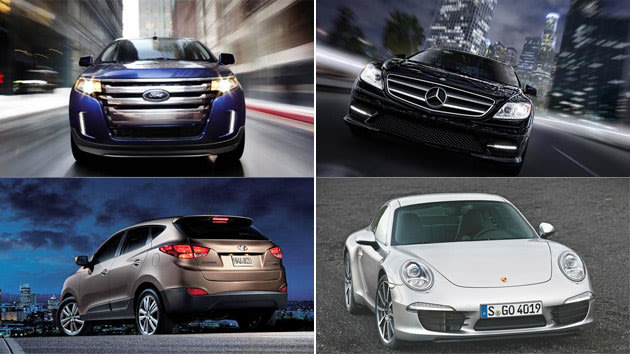 By Jim Gorzelany | Fortune – Thu, Jan 17, 2013 4:58 PM EST
By Jim Gorzelany | Fortune – Thu, Jan 17, 2013 4:58 PM EST

MORE AT FORBES
According to an extensive survey of more than 750 car models and six major carriers conducted for Insure.com, crossover SUVS dominate the rankings of least expensive vehicles to insure for 2013.
“In the past, minivans have dominated the ‘least expensive to insure’ rankings,” says Amy Danise, editorial director of Insure.com. “But SUVs and crossovers have parked themselves in the best spots in the rankings for the 2013 model year.”
By comparison, the costliest car to insure (excluding exotics), the posh Mercedes-Benz CL600 luxury coupe, gnaws at its owners’ pocketbooks with a stiff yearly premium.
Of course, costlier cars are always more expensive to ensure. Their overall replacement values are greater and their repair costs tend to be more expensive than other types of vehicles. Beyond that, insurance companies look at past claims histories to determine which models incur more or less damage in a crash, are more or less damaging to other vehicles, people and property, are more or less likely to be stolen or be involved in a crash and have higher or lower bodily injury claims. By that measure, high-performance cars tend to be costly to insure because they tend to be driven more aggressively and are, in turn, involved in a proportionately higher percentage of accidents than more sedate sedans and SUVs.
Data on premiums for the survey was compiled by Quadrant Information Services based on auto insurance rates for more than 750 car and truck models from six large carriers – Allstate, Farmers, GEICO, Nationwide, Progressive and State Farm – in 10 ZIP codes per state. Rates were not available for all models, particularly exotic cars. Averages assume a single, 40-year-old male with a clean driving record and good credit who commutes 12 miles to work each day, with policy limits of 100/300/50 ($100,000 for injury liability for one person, $300,000 for all injuries and $50,000 for property damage in an accident) and a $500 deductible on collision and comprehensive coverage.
Of course, “your mileage may vary.” Demographically, women and married men tend to pay the lowest premiums, with younger men (the most accident prone group of all) being charged the highest rates for a given make and model. You’ll pay higher rates if there’s multiple tickets and/or accidents on your driving record, you live in a big city, and/or drive an excessive number of miles per year, among other factors; if you have a DUI on your record or are considered a poor credit risk you may not be able to obtain auto insurance at all, depending on the carrier.
And yes, be sure to comparison shop among multiple carriers, ask about discounts and consider raising your policy’s deductibles to further minimize your annual auto insurance premiums.
The least expensive 2013 vehicles to insure
| Rank | Make & model | Cyl. | Avg. annual premium |
| 1 | Ford Edge SE | 4 | $ 1,128 |
| 2 | Jeep Grand Cherokee Laredo | 6 | $ 1,148 |
| 3 | Subaru Outback 2.5i Premium | 4 | $ 1,150 |
| 4 | Kia Sportage | 4 | $ 1,157 |
| 5 | Jeep Patriot Sport | 4 | $ 1,160 |
| 6 | Chevrolet Express 1500 | 8 | $ 1,171 |
| 7 | Subaru Outback 3.6R | 6 | $ 1,180 |
| 8 | Hyundai Tucson GLS | 4 | $ 1,189 |
| 9 | Ford Explorer | 6 | $ 1,197 |
| 10 | Hyundai Tucson GL | 4 | $ 1,204 |
The most expensive 2013 vehicles to insure
| Rank | Make & model | Cyl. | Avg. annual premium |
| 1 | Mercedes-Benz CL600 | 12 | $ 3,357 |
| 2 | Mercedes-Benz CL65 AMG | 12 | $ 3,330 |
| 3 | Mercedes-Benz S65 AMG | 8 | $ 3,221 |
| 4 | Mercedes-Benz SL65 AMG | 12 | $ 3,207 |
| 5 | Mercedes-Benz CL63 AMG | 8 | $ 3,184 |
| 6 | Mercedes-Benz S600 | 12 | $ 3,158 |
| 7 | Mercedes-Benz SL63 AMG | 8 | $ 3,075 |
| 8 | Mercedes-Benz S63 AMG | 8 | $ 2,978 |
| 9 | Porsche 911 Turbo | 6 | $ 2,958 |
| 10 | Porsche 911 Turbo S | 6 | $ 2,925 |
[Related: See more of the Cheapest Cars To Insure]
No comments:
Post a Comment